Tutorial 6: Scenario-dependence of Future Changes in Extremes
Contents
Tutorial 6: Scenario-dependence of Future Changes in Extremes#
Week 2, Day 4, Extremes & Vulnerability
Content creators: Matthias Aengenheyster, Joeri Reinders
Content reviewers: Younkap Nina Duplex, Sloane Garelick, Zahra Khodakaramimaghsoud, Peter Ohue, Laura Paccini, Jenna Pearson, Agustina Pesce, Derick Temfack, Peizhen Yang, Cheng Zhang, Chi Zhang, Ohad Zivan
Content editors: Jenna Pearson, Chi Zhang, Ohad Zivan
Production editors: Wesley Banfield, Jenna Pearson, Chi Zhang, Ohad Zivan
Our 2023 Sponsors: NASA TOPS and Google DeepMind
Tutorial Objectives#
In this tutorial, we will analyze climate model output for various cities worldwide to investigate the changes in extreme temperature and precipitation patterns over time under different emission scenarios.
The data we will be using consists of climate model simulations for the historical period and three future climate scenarios:
Historical (hist): This scenario covers the time range from 1851 to 2014 and incorporates information about volcanic eruptions, greenhouse gas emissions, and other factors relevant to historical climate conditions.
The Socio-economic pathway (SSP) scenarios represent potential climate futures beyond 2014. It’s important to note that these scenarios are predictions (“this is what we think will happen”) but are not certainties (“this is plausible given the assumptions”). Each scenario is based on different assumptions, primarily concerning the speed and effectiveness of global efforts to address global warming and reduce greenhouse gas emissions and other pollutants. Here are the scenarios we will be using today, along with desciptions (see Section 1.6 of the recent IPCC AR6 WG1 report for more detail)
SSP1-2.6 (ambitious climate scenario): This scenario stays below 2.0°C warming relative to 1850–1900 (median) with implied net zero CO2 emissions in the second half of the century.
SSP2-4.5 (middle-ground climate scenario): This scenario is in line with the upper end of aggregate NDC (nationally-defined contribution) emissions levels by 2030. CO2 emissions remain around current levels until the middle of the century. The SSP2-4.5 scenario deviates mildly from a ‘no-additional-climate-policy’ reference scenario, resulting in a best-estimate warming around 2.7°C by the end of the 21st century relative to 1850–1900 (Chapter 4).
SSP5-8.5 (pessimistic climate scenario): The highest emissions scenario with no additional climate policy and where CO2 emissions roughly double from current levels by 2050. Emissions levels as high as SSP5-8.5 are not obtained by integrated assessment models (IAMs) under any of the SSPs other than the fossil-fuelled SSP5 socio-economic development pathway. It exhibits the highest level of warming among all scenarios and is often used as a “worst-case scenario” (though it may not be the most likely outcome). It is worth noting that many experts today consider this scenario to be unlikely due to significant improvements in mitigation policies over the past decade or so.
By the end of this tutorial, you will be able to:
Utilize climate model output from scenario runs to assess changes during the historical period.
Compare potential future climate scenarios, focusing on their impact on extreme events.
Setup#
# !pip install -q condacolab
# import condacolab
# condacolab.install()
# imports
import xarray as xr
import numpy as np
import matplotlib.pyplot as plt
import seaborn as sns
import pandas as pd
import cartopy.crs as ccrs
from scipy import stats
from scipy.stats import genextreme as gev
from datetime import datetime
import os
import pooch
import tempfile
Figure Settings#
Figure Settings#
# @title Figure Settings
import ipywidgets as widgets # interactive display
%config InlineBackend.figure_format = 'retina'
plt.style.use(
"https://raw.githubusercontent.com/ClimateMatchAcademy/course-content/main/cma.mplstyle"
)
Helper functions#
Helper functions#
# @title Helper functions
def estimate_return_level_period(period, loc, scale, shape):
"""
Compute GEV-based return level for a given return period, and GEV parameters
"""
return stats.genextreme.ppf(1 - 1 / period, shape, loc=loc, scale=scale)
def empirical_return_level(data):
"""
Compute empirical return level using the algorithm introduced in Tutorial 2
"""
df = pd.DataFrame(index=np.arange(data.size))
# sort the data
df["sorted"] = np.sort(data)[::-1]
# rank via scipy instead to deal with duplicate values
df["ranks_sp"] = np.sort(stats.rankdata(-data))
# find exceedence probability
n = data.size
df["exceedance"] = df["ranks_sp"] / (n + 1)
# find return period
df["period"] = 1 / df["exceedance"]
df = df[::-1]
out = xr.DataArray(
dims=["period"],
coords={"period": df["period"]},
data=df["sorted"],
name="level",
)
return out
def fit_return_levels(data, years, N_boot=None, alpha=0.05):
"""
Fit GEV to data, compute return levels and confidence intervals
"""
empirical = (
empirical_return_level(data)
.rename({"period": "period_emp"})
.rename("empirical")
)
shape, loc, scale = gev.fit(data, 0)
print("Location: %.1e, scale: %.1e, shape: %.1e" % (loc, scale, shape))
central = estimate_return_level_period(years, loc, scale, shape)
out = xr.Dataset(
# dims = ['period'],
coords={"period": years, "period_emp": empirical["period_emp"]},
data_vars={
"empirical": (["period_emp"], empirical.data),
"GEV": (["period"], central),
},
)
if N_boot:
levels = []
shapes, locs, scales = [], [], []
for i in range(N_boot):
datai = np.random.choice(data, size=data.size, replace=True)
# print(datai.mean())
shapei, loci, scalei = gev.fit(datai, 0)
shapes.append(shapei)
locs.append(loci)
scales.append(scalei)
leveli = estimate_return_level_period(years, loci, scalei, shapei)
levels.append(leveli)
levels = np.array(levels)
quant = alpha / 2, 1 - alpha / 2
quantiles = np.quantile(levels, quant, axis=0)
print("Ranges with alpha=%.3f :" % alpha)
print("Location: [%.2f , %.2f]" % tuple(np.quantile(locs, quant).tolist()))
print("Scale: [%.2f , %.2f]" % tuple(np.quantile(scales, quant).tolist()))
print("Shape: [%.2f , %.2f]" % tuple(np.quantile(shapes, quant).tolist()))
quantiles = xr.DataArray(
dims=["period", "quantiles"],
coords={"period": out.period, "quantiles": np.array(quant)},
data=quantiles.T,
)
out["range"] = quantiles
return out
def plot_return_levels(obj, c="C0", label="", ax=None):
"""
Plot fitted data:
- empirical return level
- GEV-fitted return level
- alpha-confidence ranges with bootstrapping (if N_boot is given)
"""
if not ax:
ax = plt.gca()
obj["GEV"].plot.line("%s-" % c, lw=3, _labels=False, label=label, ax=ax)
obj["empirical"].plot.line("%so" % c, mec="k", markersize=5, _labels=False, ax=ax)
if "range" in obj:
# obj['range'].plot.line('k--',hue='quantiles',label=obj['quantiles'].values)
ax.fill_between(obj["period"], *obj["range"].T, alpha=0.3, lw=0, color=c)
ax.semilogx()
ax.legend()
Video 1: Speaker Introduction#
Video 1: Speaker Introduction#
# @title Video 1: Speaker Introduction
# Tech team will add code to format and display the video
# helper functions
def pooch_load(filelocation=None, filename=None, processor=None):
shared_location = "/home/jovyan/shared/Data/tutorials/W2D4_ClimateResponse-Extremes&Variability" # this is different for each day
user_temp_cache = tempfile.gettempdir()
if os.path.exists(os.path.join(shared_location, filename)):
file = os.path.join(shared_location, filename)
else:
file = pooch.retrieve(
filelocation,
known_hash=None,
fname=os.path.join(user_temp_cache, filename),
processor=processor,
)
return file
Section 1: Load CMIP6 Data#
As in IPCC Physical Basis Day, you will be loading (Coupled Model Intercomparison Project 6) CMIP6 data from Pangeo. In this way you can access large amounts of climate model output that has been stored in the cloud. Here, we have already accessed the data of interest and collected it into a .nc file for you. However, the information on how to access this data directly is provided in the Resources section at the end of this notebook.
Here you will load precipitation and maximum daily near-surface air temperature.
# download file: 'cmip6_data_city_daily_scenarios_tasmax_pr_models.nc'
filename_cmip6_data = "cmip6_data_city_daily_scenarios_tasmax_pr_models.nc"
url_cmip6_data = "https://osf.io/ngafk/download"
data = xr.open_dataset(pooch_load(url_cmip6_data, filename_cmip6_data))
Section 2: Inspect Data#
data
<xarray.Dataset>
Dimensions: (model: 2, city: 6, bnds: 2, scenario: 3, time: 91676)
Coordinates:
lat (model, city) float64 ...
lat_bnds (model, city, bnds) float64 ...
lon (model, city) float64 ...
lon_bnds (model, city, bnds) float64 ...
* time (time) datetime64[ns] 1850-01-01T12:00:00 ... 2100-12-31T...
time_bnds (time, bnds) datetime64[ns] ...
member_id object ...
dcpp_init_year float64 ...
height float64 ...
* city (city) object 'Hamburg' 'Madrid' ... 'Phoenix' 'Sydney'
* scenario (scenario) object 'ssp126' 'ssp245' 'ssp585'
* model (model) object 'MPI-ESM1-2-HR' 'MIROC6'
Dimensions without coordinates: bnds
Data variables:
pr (model, city, scenario, time) float64 ...
tasmax (model, city, scenario, time) float32 ...
Attributes: (12/56)
Conventions: CF-1.7 CMIP-6.2
activity_id: CMIP
branch_method: standard
branch_time_in_child: 0.0
branch_time_in_parent: 0.0
cmor_version: 3.5.0
... ...
intake_esm_attrs:member_id: r1i1p1f1
intake_esm_attrs:table_id: day
intake_esm_attrs:grid_label: gn
intake_esm_attrs:version: 20190710
intake_esm_attrs:_data_format_: zarr
intake_esm_dataset_key: CMIP.MPI-M.MPI-ESM1-2-HR.historical.day.gndata.pr
<xarray.DataArray 'pr' (model: 2, city: 6, scenario: 3, time: 91676)>
[3300336 values with dtype=float64]
Coordinates:
lat (model, city) float64 ...
lon (model, city) float64 ...
* time (time) datetime64[ns] 1850-01-01T12:00:00 ... 2100-12-31T...
member_id object ...
dcpp_init_year float64 ...
height float64 ...
* city (city) object 'Hamburg' 'Madrid' ... 'Phoenix' 'Sydney'
* scenario (scenario) object 'ssp126' 'ssp245' 'ssp585'
* model (model) object 'MPI-ESM1-2-HR' 'MIROC6'
Attributes:
cell_measures: area: areacella
cell_methods: area: time: mean
comment: includes both liquid and solid phases
history: 2019-08-25T06:42:13Z altered by CMOR: replaced missing va...
long_name: Precipitation
original_name: pr
standard_name: precipitation_flux
units: mm/daydata.tasmax
<xarray.DataArray 'tasmax' (model: 2, city: 6, scenario: 3, time: 91676)>
[3300336 values with dtype=float32]
Coordinates:
lat (model, city) float64 ...
lon (model, city) float64 ...
* time (time) datetime64[ns] 1850-01-01T12:00:00 ... 2100-12-31T...
member_id object ...
dcpp_init_year float64 ...
height float64 ...
* city (city) object 'Hamburg' 'Madrid' ... 'Phoenix' 'Sydney'
* scenario (scenario) object 'ssp126' 'ssp245' 'ssp585'
* model (model) object 'MPI-ESM1-2-HR' 'MIROC6'
Attributes:
cell_measures: area: areacella
cell_methods: area: mean time: maximum
comment: maximum near-surface (usually, 2 meter) air temperature (...
history: 2019-08-25T06:42:13Z altered by CMOR: Treated scalar dime...
long_name: Daily Maximum Near-Surface Air Temperature
standard_name: air_temperature
units: KYou can take a little time to explore the different variables within this dataset.
Section 2: Processing#
Let’s look at the data for one selected city, for one climate model. In this case here, we choose Madrid and the MPI-ESM1-2-HR model.
city = "Madrid"
data_city = data.sel(city=city, model="MPI-ESM1-2-HR")
data_city
<xarray.Dataset>
Dimensions: (bnds: 2, scenario: 3, time: 91676)
Coordinates:
lat float64 ...
lat_bnds (bnds) float64 ...
lon float64 ...
lon_bnds (bnds) float64 ...
* time (time) datetime64[ns] 1850-01-01T12:00:00 ... 2100-12-31T...
time_bnds (time, bnds) datetime64[ns] ...
member_id object ...
dcpp_init_year float64 ...
height float64 ...
city <U6 'Madrid'
* scenario (scenario) object 'ssp126' 'ssp245' 'ssp585'
model <U13 'MPI-ESM1-2-HR'
Dimensions without coordinates: bnds
Data variables:
pr (scenario, time) float64 ...
tasmax (scenario, time) float32 ...
Attributes: (12/56)
Conventions: CF-1.7 CMIP-6.2
activity_id: CMIP
branch_method: standard
branch_time_in_child: 0.0
branch_time_in_parent: 0.0
cmor_version: 3.5.0
... ...
intake_esm_attrs:member_id: r1i1p1f1
intake_esm_attrs:table_id: day
intake_esm_attrs:grid_label: gn
intake_esm_attrs:version: 20190710
intake_esm_attrs:_data_format_: zarr
intake_esm_dataset_key: CMIP.MPI-M.MPI-ESM1-2-HR.historical.day.gnThe data has daily resolution, for three climate scenarios. Until 2014 the scenarios are identical (the ‘historical’ scenario). After 2014 they diverge given different climate change trajectories. Let’s plot these two variables over time to get a sense of this.
# setup plot
fig, ax = plt.subplots(2, sharex=True, figsize=(10, 5), constrained_layout=True)
data_city["tasmax"].plot(hue="scenario", ax=ax[0], lw=0.5)
data_city["pr"].plot(hue="scenario", ax=ax[1], lw=0.5, add_legend=False)
ax[0].set_title("Maximum Daily Near-Surface Air Temperature")
ax[1].set_title("Precipitation")
ax[0].set_xlabel("")
ax[0].set_ylabel("K")
ax[1].set_ylabel("mm/day")
ax[0].set_xlim(datetime(1850, 1, 1), datetime(2100, 12, 31))
ax[1].set_ylim(0, None);
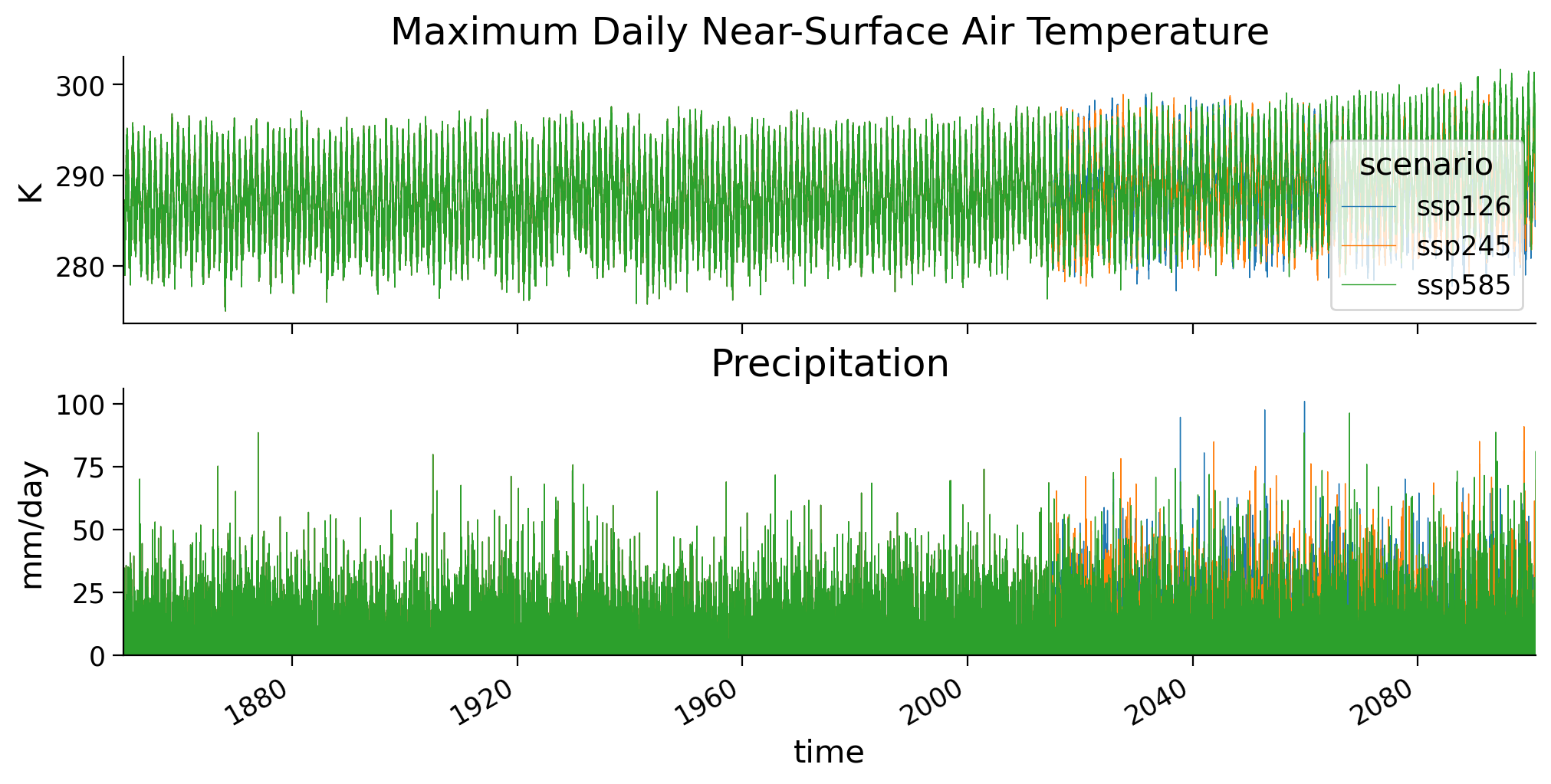
In the previous tutorials we have been operating on annual maxima data - looking at the most extreme event observed in each year. We will do the same here: take the day in each year with the highest temperature or the largest amount of rainfall
fig, ax = plt.subplots(2, sharex=True, figsize=(10, 5), constrained_layout=True)
data_city["tasmax"].resample(time="1Y").max().plot(hue="scenario", ax=ax[0], lw=2)
data_city["pr"].resample(time="1Y").max().plot(
hue="scenario", ax=ax[1], lw=2, add_legend=False
)
ax[0].set_title("Annual Maximum of Daily Maximum Near-Surface Air Temperature")
ax[1].set_title("Annual Maximum of Daily Precipitation")
ax[0].set_xlabel("")
ax[0].set_ylabel("K")
ax[1].set_ylabel("mm/day")
ax[0].set_xlim(datetime(1850, 1, 1), datetime(2100, 12, 31))
ax[1].set_ylim(0, None);

Questions 2#
Describe the plot - what do you see for the two variables, over time, between scenarios?
Section 3: Differences Between Historical Periods#
As in the previous tutorial we want to compare consecutive 30-year periods in the past: therefore take the historical run (1850-2014), and look at the annual maximum daily precipitation for the last three 30-year periods. We only need to look at one scenario because they all use the historical run until 2014.
# take max daily precip values from Madrid for three climate normal periods
pr_city = data_city["pr"]
pr_city_max = pr_city.resample(time="1Y").max()
data_period1 = (
pr_city_max.sel(scenario="ssp245", time=slice("2014"))
.sel(time=slice("1925", "1954"))
.to_dataframe()["pr"]
)
data_period2 = (
pr_city_max.sel(scenario="ssp245", time=slice("2014"))
.sel(time=slice("1955", "1984"))
.to_dataframe()["pr"]
)
data_period3 = (
pr_city_max.sel(scenario="ssp245", time=slice("2014"))
.sel(time=slice("1985", "2014"))
.to_dataframe()["pr"]
)
Plot the histograms of annual maximum daily precipitation for the three climate normals covering the historical period. What do you see? Compare to the analysis in the previous tutorial where we analyzed sea level height. Any similarities or differences? Why do you think that is?
# plot histograms for climate normals during historical period
fig, ax = plt.subplots()
sns.histplot(
data_period1,
bins=np.arange(20, 90, 5),
color="C0",
element="step",
alpha=0.5,
kde=True,
label="1925-1954",
ax=ax,
)
sns.histplot(
data_period2,
bins=np.arange(20, 90, 5),
color="C1",
element="step",
alpha=0.5,
kde=True,
label="1955-1984",
ax=ax,
)
sns.histplot(
data_period3,
bins=np.arange(20, 90, 5),
color="C2",
element="step",
alpha=0.5,
kde=True,
label="1985-2014",
ax=ax,
)
ax.legend()
ax.set_xlabel("Annual Maximum Daily Precipitation (mm/day)")
Text(0.5, 0, 'Annual Maximum Daily Precipitation (mm/day)')
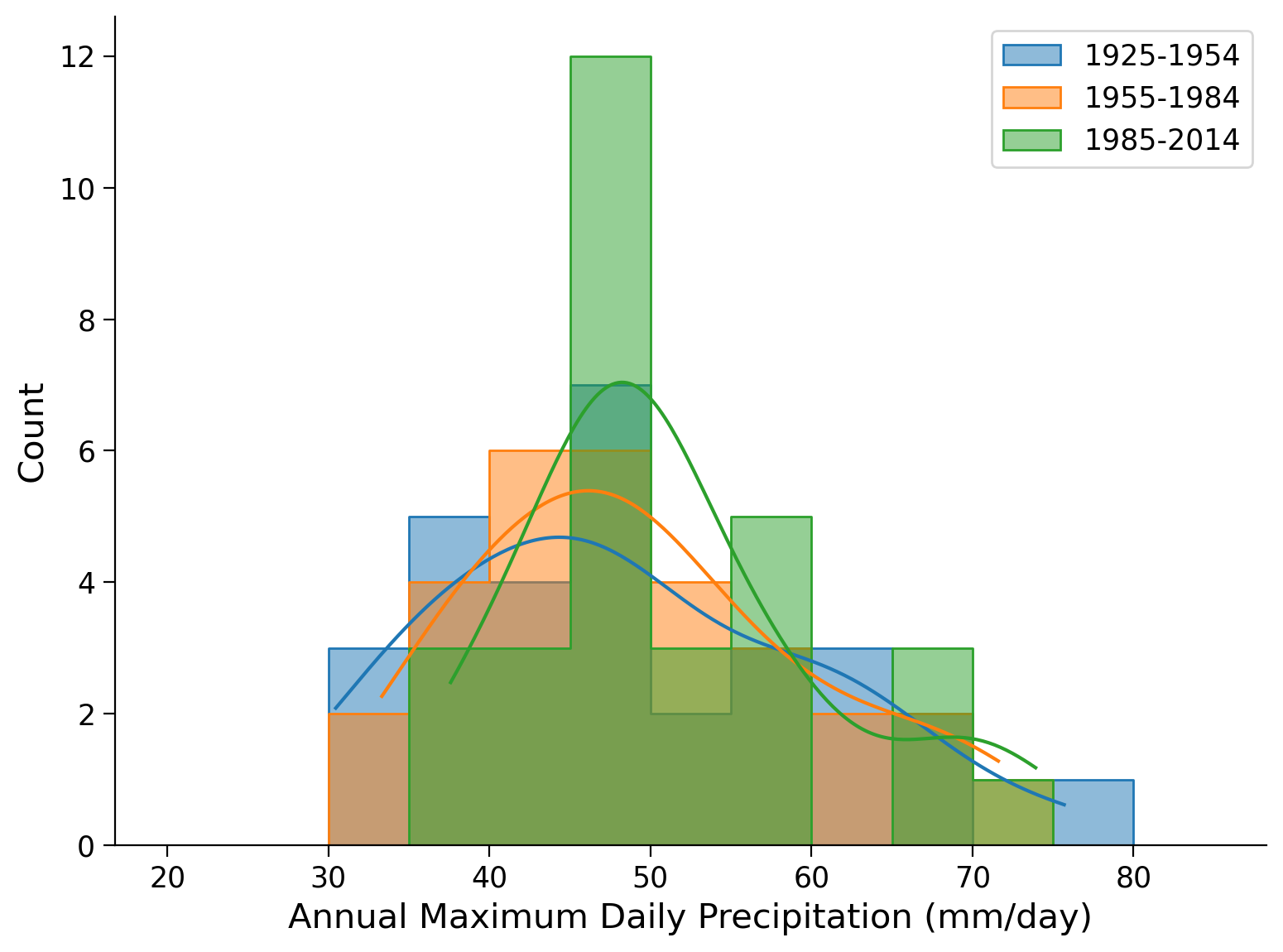
# calculate moments of the data
periods_stats = pd.DataFrame(index=["Mean", "Standard Deviation", "Skew"])
periods_stats["1925-1954"] = [
data_period1.mean(),
data_period1.std(),
data_period1.skew(),
]
periods_stats["1955-1984"] = [
data_period2.mean(),
data_period2.std(),
data_period2.skew(),
]
periods_stats["1985-2014"] = [
data_period3.mean(),
data_period3.std(),
data_period3.skew(),
]
periods_stats = periods_stats.T
periods_stats
| Mean | Standard Deviation | Skew | |
|---|---|---|---|
| 1925-1954 | 48.430939 | 11.521903 | 0.485490 |
| 1955-1984 | 49.461359 | 10.390394 | 0.547118 |
| 1985-2014 | 51.412866 | 9.354812 | 0.905246 |
Now, we fit a GEV to the three time periods, and plot the distributions using the gev.pdf function:
# reminder of how to fit function works and the output shape parameters
gev = stats.genextreme
gev.fit(data_period1.values)
(0.09307355209208032, 43.51828403778693, 9.769295887460995)
# fit GEV distribution for three climate normals during historical period
params_period1 = gev.fit(data_period1, 0)
shape_period1, loc_period1, scale_period1 = params_period1
params_period2 = gev.fit(data_period2, 0)
shape_period2, loc_period2, scale_period2 = params_period2
params_period3 = gev.fit(data_period3, 0)
shape_period3, loc_period3, scale_period3 = params_period3
# plot corresponding PDFs of GEV distribution fits
fig, ax = plt.subplots()
x = np.linspace(20, 90, 1000)
ax.plot(
x,
gev.pdf(x, shape_period1, loc=loc_period1, scale=scale_period1),
c="C0",
lw=3,
label="1925-1954",
)
ax.plot(
x,
gev.pdf(x, shape_period2, loc=loc_period2, scale=scale_period2),
c="C1",
lw=3,
label="1955-1984",
)
ax.plot(
x,
gev.pdf(x, shape_period3, loc=loc_period3, scale=scale_period3),
c="C2",
lw=3,
label="1985-2014",
)
ax.legend()
ax.set_xlabel("Annual Maximum Daily Precipitation (mm/day)")
ax.set_ylabel("Density")
Text(0, 0.5, 'Density')
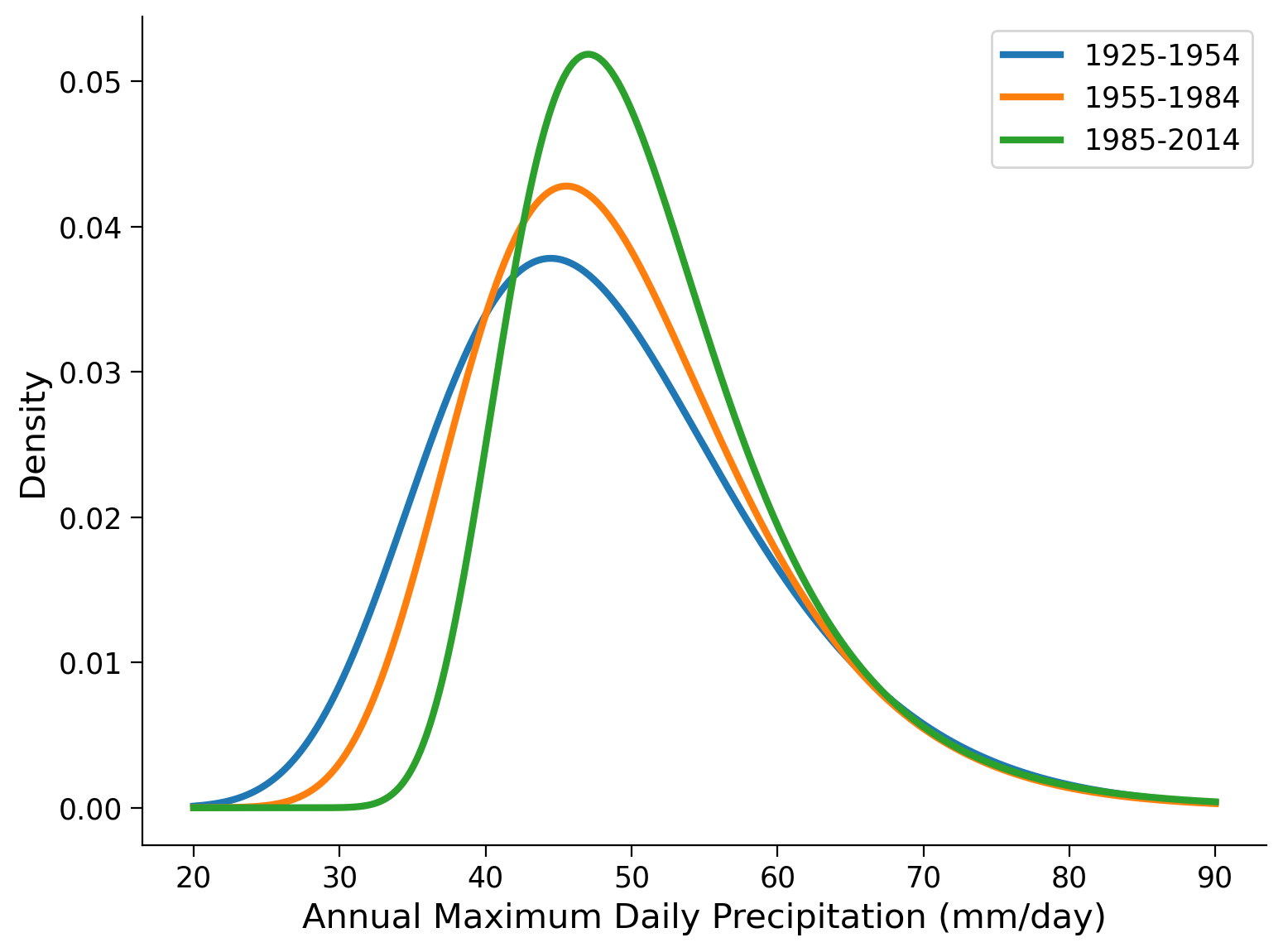
# show the parameters of the GEV fit
parameters = pd.DataFrame(index=["Location", "Scale", "Shape"])
parameters["1925-1954"] = [loc_period1, scale_period1, shape_period1]
parameters["1955-1984"] = [loc_period2, scale_period2, shape_period2]
parameters["1985-2014"] = [loc_period3, scale_period3, shape_period3]
parameters = parameters.T
parameters.round(4) # .astype('%.2f')
| Location | Scale | Shape | |
|---|---|---|---|
| 1925-1954 | 43.5183 | 9.7693 | 0.0931 |
| 1955-1984 | 44.9420 | 8.6153 | 0.0673 |
| 1985-2014 | 47.1629 | 7.0925 | -0.0177 |
Now we will create a return level plot for the three periods. To do so we will be using some helper functions defined at the beginning of the tutorial, most of which you have seen before. In particular we will use fit_return_levels to generate an xr.Dataset that contains empirical and GEV fits, as well as confidence intervals, and plot_return_levels to generate a plot from this xr.Dataset with calculated confidence intervals shaded (alpha printed below).
These functions can also be found in gev_functions (import gev_functions as gf).
fit_period1 = fit_return_levels(
data_period1, np.arange(1.1, 1000, 0.1), N_boot=100, alpha=0.05
)
fit_period2 = fit_return_levels(
data_period2, np.arange(1.1, 1000, 0.1), N_boot=100, alpha=0.05
)
fit_period3 = fit_return_levels(
data_period3, np.arange(1.1, 1000, 0.1), N_boot=100, alpha=0.05
)
Location: 4.4e+01, scale: 9.8e+00, shape: 9.3e-02
Ranges with alpha=0.050 :
Location: [39.73 , 49.05]
Scale: [7.03 , 12.10]
Shape: [-0.17 , 0.70]
Location: 4.5e+01, scale: 8.6e+00, shape: 6.7e-02
Ranges with alpha=0.050 :
Location: [42.12 , 49.24]
Scale: [6.21 , 12.70]
Shape: [-0.18 , 0.43]
Location: 4.7e+01, scale: 7.1e+00, shape: -1.8e-02
Ranges with alpha=0.050 :
Location: [44.47 , 49.94]
Scale: [4.83 , 8.99]
Shape: [-0.28 , 0.22]
fig, ax = plt.subplots()
plot_return_levels(fit_period1, c="C0", label="1925-1954", ax=ax)
plot_return_levels(fit_period2, c="C1", label="1955-1984", ax=ax)
plot_return_levels(fit_period3, c="C2", label="1985-2014", ax=ax)
ax.set_xlim(1.5, 1000)
ax.set_ylim(40, 140)
ax.legend()
ax.set_ylabel("Return Level (mm/day)")
ax.set_xlabel("Return Period (years)")
Text(0.5, 0, 'Return Period (years)')
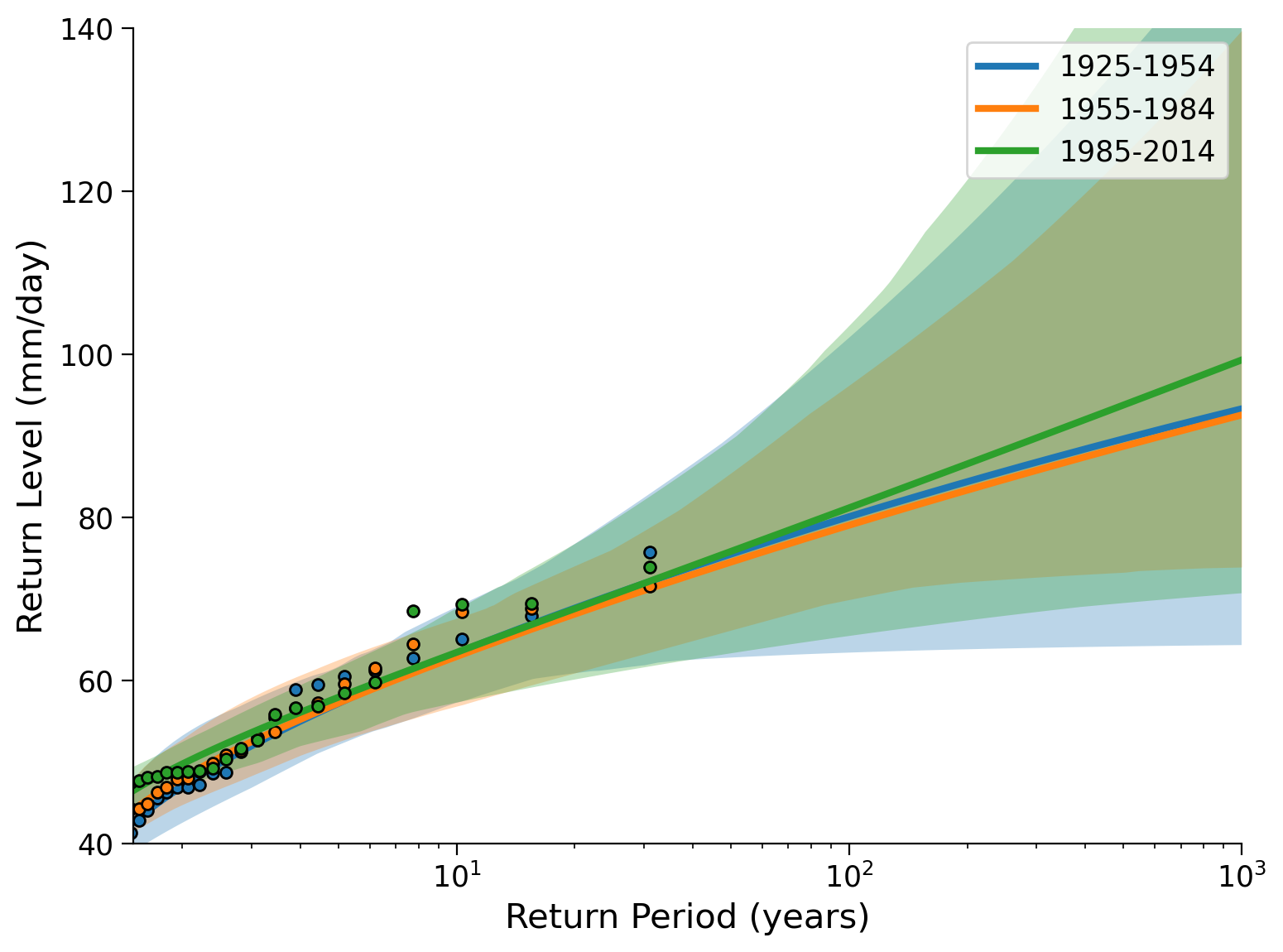
Questions 3#
What do you conclude for the historical change in extreme precipitation in this city? What possible limitations could this analysis have? (How) could we address this?
Section 4: Climate Futures#
Now let’s look at maximum precipitation in possible climate futures: the years 2071-2100 (the last 30 years). For comparison we use the historical period, 1850-2014.
In the next box we select the data, then you will plot it as a coding exercise:
data_city = data.sel(city=city, model="MPI-ESM1-2-HR")
# data_city = data.sel(city=city,model='MIROC6')
data_city_fut = (
data_city["pr"].sel(time=slice("2071", "2100")).resample(time="1Y").max()
)
# select the different time periods
data_hist = (
data_city["pr"]
.sel(scenario="ssp126", time=slice("1850", "2014"))
.resample(time="1Y")
.max()
.to_dataframe()["pr"]
)
data_ssp126 = data_city_fut.sel(scenario="ssp126").to_dataframe()["pr"]
data_ssp245 = data_city_fut.sel(scenario="ssp245").to_dataframe()["pr"]
data_ssp585 = data_city_fut.sel(scenario="ssp585").to_dataframe()["pr"]
Coding Exercises 4#
Differences between climate scenarios:
Repeat the analysis that we did above for three different time periods, but now for three different climate scenarios, and the historical period for comparison.
Create a figure that displays the histograms of the four records. Find a useful number and spacing of bins (via the bins= keyword to sns.histplot). Calculate the moments.
Fit GEV distributions to the four records using the same commands as above. Use the
gev.pdffunction to plot the fitted distributions.Inspect location, scale and shape parameters
Create a return-level plot using the
ef.plot_levels_from_objfunction.
# setup plot
fig, ax = plt.subplots()
# create histograms for each scenario and historical
# Uncomment and complete
# sns.histplot(
# ...,
# bins=np.arange(30, 100, 5),
# color="k",
# element="step",
# stat="density",
# alpha=0.3,
# lw=0.5,
# line_kws=dict(lw=3),
# kde=True,
# label="Historical, 1850-2014",
# ax=ax,
# )
# sns.histplot(
# ...,
# bins=np.arange(30, 100, 5),
# color="C0",
# element="step",
# stat="density",
# alpha=0.3,
# lw=0.5,
# line_kws=dict(lw=3),
# kde=True,
# label="SSP-126, 2071-2100",
# ax=ax,
# )
# sns.histplot(
# ...,
# bins=np.arange(30, 100, 5),
# color="C0",
# element="step",
# stat="density",
# alpha=0.3,
# lw=0.5,
# line_kws=dict(lw=3),
# kde=True,
# label="SSP-126, 2071-2100",
# ax=ax,
# )
# sns.histplot(
# ...,
# bins=np.arange(30, 100, 5),
# color="C1",
# element="step",
# stat="density",
# alpha=0.3,
# lw=0.5,
# line_kws=dict(lw=3),
# kde=True,
# label="SSP-245, 2071-2100",
# ax=ax,
# )
# sns.histplot(
# ...,
# bins=np.arange(30, 100, 5),
# color="C2",
# element="step",
# stat="density",
# alpha=0.3,
# lw=0.5,
# line_kws=dict(lw=3),
# kde=True,
# label="SSP-585, 2071-2100",
# ax=ax,
# )
# aesthetics
ax.legend()
ax.set_xlabel("Annual Maximum Daily Precipitation (mm/day)")
# calculate moments
periods_stats = pd.DataFrame(index=["Mean", "Standard Deviation", "Skew"])
periods_stats[...] = [..., ..., ...]
periods_stats[...] = [..., ..., ...]
periods_stats[...] = [..., ..., ...]
periods_stats[...] = [..., ..., ...]
periods_stats = periods_stats.T
periods_stats
No artists with labels found to put in legend. Note that artists whose label start with an underscore are ignored when legend() is called with no argument.
| Mean | Standard Deviation | Skew | |
|---|---|---|---|
| Ellipsis | Ellipsis | Ellipsis | Ellipsis |

Example output:

# fit GEV distribution
# Uncomment and complete
# shape_hist, loc_hist, scale_hist = ...
# shape_ssp126, loc_ssp126, scale_ssp126 = ...
# shape_ssp245, loc_ssp245, scale_ssp245 = ...
# shape_ssp585, loc_ssp585, scale_ssp585 = ...
# make plots
fig, ax = plt.subplots()
x = np.linspace(20, 120, 1000)
# Uncomment and complete
# ax.plot(
# x,
# gev.pdf(x, ..., loc=..., scale=...),
# c="k",
# lw=3,
# label="historical, 1850-2014",
# )
# ax.plot(
# x,
# gev.pdf(x, ..., loc=..., scale=...),
# c="C0",
# lw=3,
# label="SSP-126, 2071-2100",
# )
# ax.plot(
# x,
# gev.pdf(x, ..., loc=..., scale=...),
# c="C1",
# lw=3,
# label="SSP-245, 2071-2100",
# )
# ax.plot(
# x,
# gev.pdf(x, ..., loc=..., scale=...),
# c="C2",
# lw=3,
# label="SSP-585, 2071-2100",
# )
ax.legend()
ax.set_xlabel("Annual Maximum Daily Precipitation (mm/day)")
ax.set_ylabel("Density");
No artists with labels found to put in legend. Note that artists whose label start with an underscore are ignored when legend() is called with no argument.
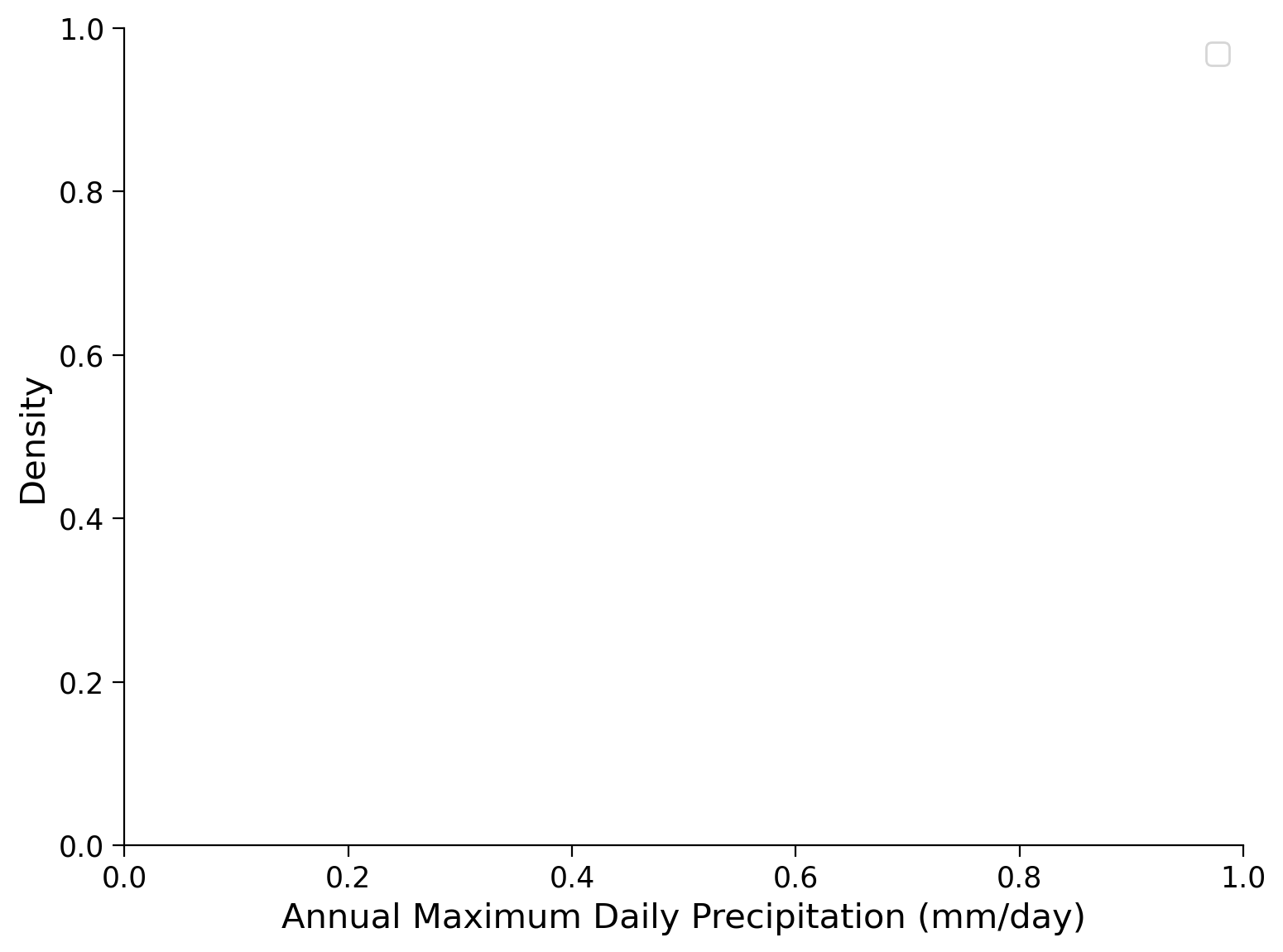
Example output:

# find return levels
# Uncomment and complete
# fit_hist = fit_return_levels(
# ..., np.arange(1.1, 200, 0.1), N_boot=100, alpha=0.05
# )
fit_ssp126 = ...
fit_ssp245 = ...
fit_ssp585 = ...
# plot
fig, ax = plt.subplots()
# Uncomment and complete
# plot_return_levels(..., c="k", label="historical, 1850-2014", ax=ax)
# plot_return_levels(..., c="C0", label="SSP-126, 2071-2100", ax=ax)
# plot_return_levels(..., c="C1", label="SSP-245, 2071-2100", ax=ax)
# plot_return_levels(..., c="C2", label="SSP-585, 2071-2100", ax=ax)
ax.set_xlim(1, 200)
ax.set_ylim(30, 110)
ax.set_ylabel("Return Level (mm/day)")
ax.set_xlabel("Return Period (years)")
Text(0.5, 0, 'Return Period (years)')
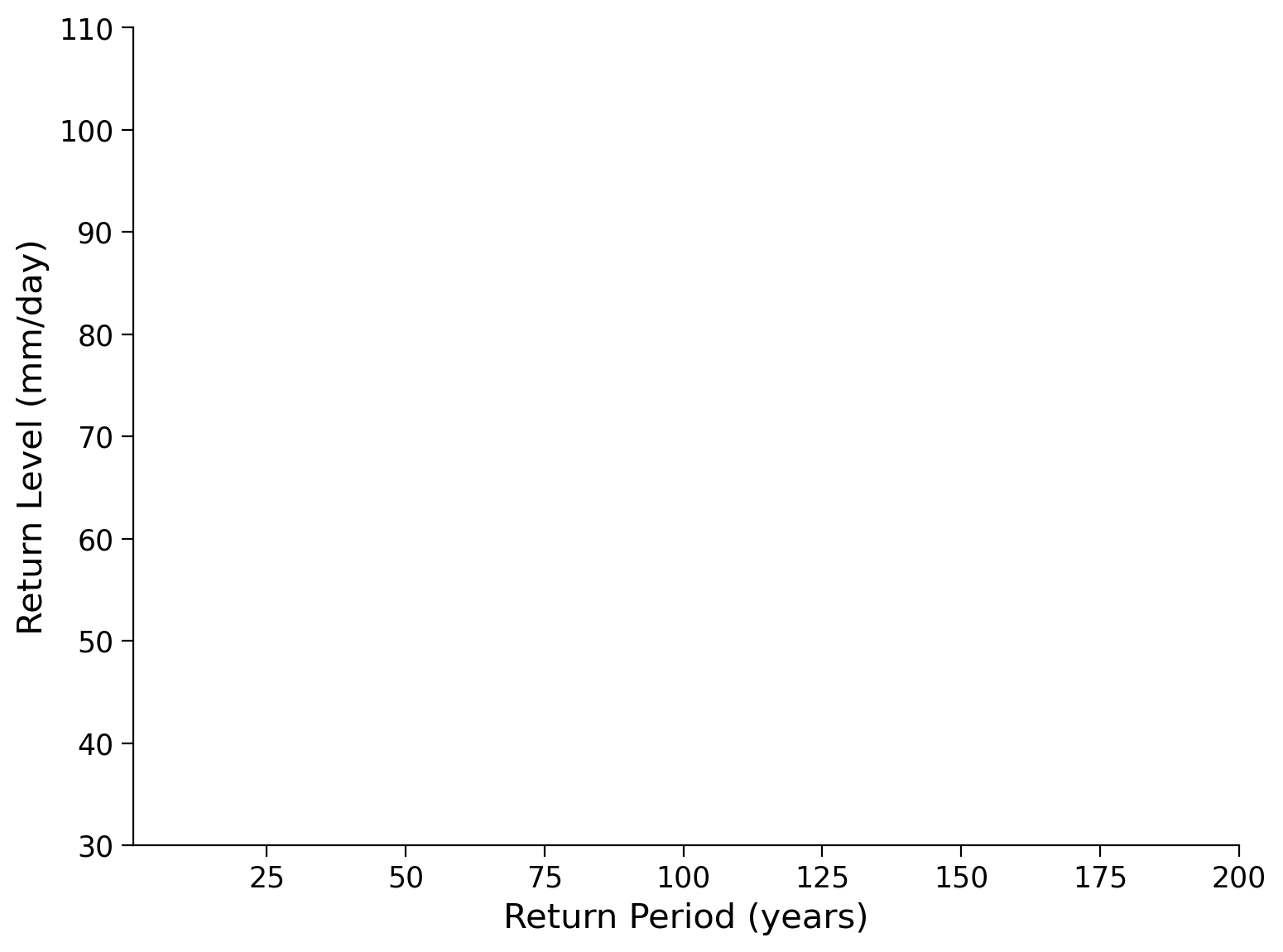
Example output:

Questions 4#
What can you say about how extreme precipitation differs between the climate scenarios? Are the differences large or small compared to periods in the historical records? What are the limitations? Consider the x-axis in the return-level plot compared to the space covered by the data (only 30 years). How could we get more information for longer return periods?
Summary#
In this tutorial, you’ve learned how to analyze climate model output to investigate the changes in extreme precipitation patterns over time under various emission scenarios and the historical period. Specifically, we’ve focused on three future Shared Socioeconomic Pathways (SSPs) scenarios, which represent potential futures based on different assumptions about greenhouse gas emissions.
You’ve explored how to fit Generalized Extreme Value (GEV) distributions to the data and used these fitted distributions to create return-level plots. These plots allow us to visualize the probability of extreme events under different climate scenarios.
Resources#
The data for this tutorial was accessed through the Pangeo Cloud platform. Additionally, a notebook is available here that downloads the specific datasets we used in this tutorial.
This tutorial uses data from the simulations conducted as part of the CMIP6 multi-model ensemble, in particular the models MPI-ESM1-2-HR and ACCESS-CM2.
MPI-ESM1-2-HR was developed and the runs conducted by the Max Planck Institute for Meteorology in Hamburg, Germany. ACCESS-CM2 was developed and the runs conducted by CSIRO (Commonwealth Scientific and Industrial Research Organisation) ARCCSS (Australian Research Council Centre of Excellence for Climate System Science), see also climateextremes.org.au.
For references on particular model experiments see this database.


